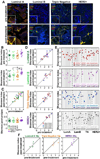Inference of tumor evolution during chemotherapy by computational modeling and in situ analysis of genetic and phenotypic cellular diversity
- PMID: 24462293
- PMCID: PMC3928845
- DOI: 10.1016/j.celrep.2013.12.041
Inference of tumor evolution during chemotherapy by computational modeling and in situ analysis of genetic and phenotypic cellular diversity
Abstract
Cancer therapy exerts a strong selection pressure that shapes tumor evolution, yet our knowledge of how tumors change during treatment is limited. Here, we report the analysis of cellular heterogeneity for genetic and phenotypic features and their spatial distribution in breast tumors pre- and post-neoadjuvant chemotherapy. We found that intratumor genetic diversity was tumor-subtype specific, and it did not change during treatment in tumors with partial or no response. However, lower pretreatment genetic diversity was significantly associated with pathologic complete response. In contrast, phenotypic diversity was different between pre- and posttreatment samples. We also observed significant changes in the spatial distribution of cells with distinct genetic and phenotypic features. We used these experimental data to develop a stochastic computational model to infer tumor growth patterns and evolutionary dynamics. Our results highlight the importance of integrated analysis of genotypes and phenotypes of single cells in intact tissues to predict tumor evolution.
Copyright © 2014 The Authors. Published by Elsevier Inc. All rights reserved.
Figures







Comment in
-
Tumor evolution in response to chemotherapy: phenotype versus genotype.Cell Rep. 2014 Feb 13;6(3):417-9. doi: 10.1016/j.celrep.2014.01.035. Cell Rep. 2014. PMID: 24529750 Free PMC article.
-
Tumour heterogeneity: the cancer kaleidoscope.Nat Rev Cancer. 2014 Mar;14(3):151-2. doi: 10.1038/nrc3683. Nat Rev Cancer. 2014. PMID: 24561429 No abstract available.
References
-
- Almendro V, Marusyk A, Polyak K. Cellular heterogeneity and molecular evolution in cancer. Annu Rev Pathol. 2013;8:277–302. - PubMed
Publication types
MeSH terms
Substances
Grants and funding
LinkOut - more resources
Full Text Sources
Other Literature Sources
Medical
Molecular Biology Databases

